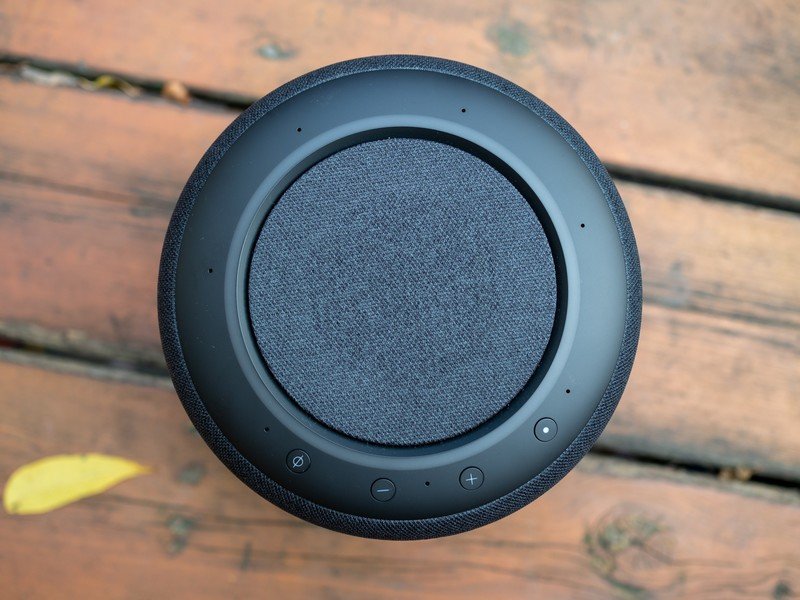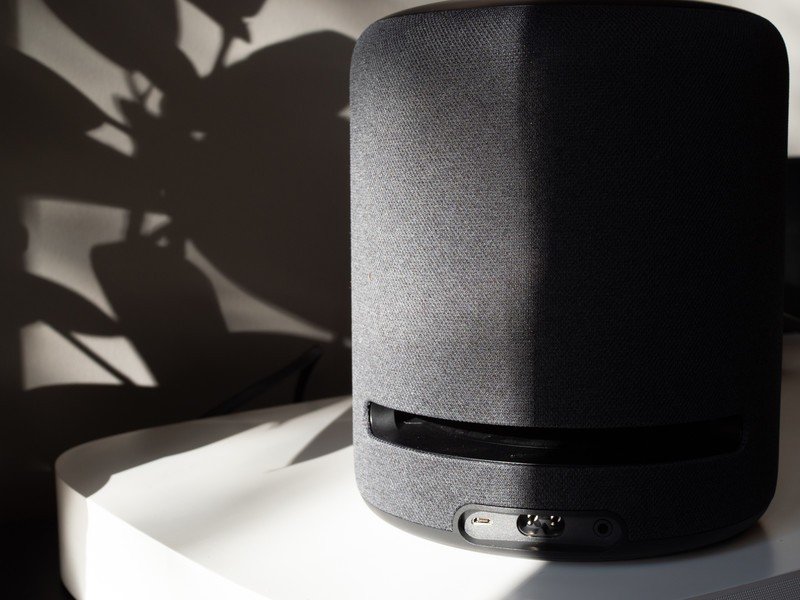Android Central Verdict
Bottom line: Amazon's new $200 Echo Studio is not a typical smart speaker, but after disabling the sound-distorting 3D upmixing, it's one of the best products in its category, especially if you're a fan of Alexa.
Pros
- +
Price is right
- +
Bright, punchy, midrange-forward sound
- +
Powerful woofer
- +
Sensitive mics can hear when the music is loud
- +
Built-in Zigbee support
Cons
- -
On-by-default 3D upmixing is terrible
- -
Dolby Atmos content is limited
Why you can trust Android Central
Amazon unveiled a lot of products during its recent media event, but of all of them — including a new pair of true wireless earbuds — I was most excited about the Echo Studio. That's because Amazon's increasingly taking sound quality, not just audio production, seriously, and the Studio is the most mainstream example of this burgeoning strategy.
And it turns out my fervor was justified: the Echo Studio is a smart speaker that outperforms nearly every other in its class, and does so at a much lower cost.
Amazon Echo Studio What sounds good

For a company whose mainstream audio products for years have promoted the notion that good enough is good enough, Amazon has dipped its toes into high-fidelity audio more than a few times. Not only has every generation of Echo, Echo Plus, Echo Dot and Echo Show sounded better than the one before, but last year saw Amazon unveil a dedicated subwoofer and a set of plug-and-play add-ons that brought Alexa to existing stereo systems.
The Echo Studio sounds better than I expected and outperforms many speakers considerably more expensive.
This year, the Echo Studio furthers that narrative and moves it from the market's edges to the mainstream: this is the speaker to buy for anyone who wants to play in the big leagues of sound without getting overly complicated. The Echo Show has enough amplification to fill a room without distorting and the aural chops to back it up, including three 2-inch mid-range speakers providing distinct coverage directions, along with a front-firing 1-inch tweeter and a downward-facing woofer.
And it sounds good. While the current-generation Echo and Echo Plus have enough low-end to please most listeners, the sound is still thin and distorts easily at high volumes. The Echo Studio does not: it automatically calibrates its equalization based on room conditions, using its seven microphones to listen for echo and other environmental factors, and blasts sound with confidence.



Source: Daniel Bader / Android Central
I spent a lot of time comparing the $199 Echo Studio to the now-$299 Google Home Max, the $199 Sonos One, and the $399 Sonos Move, and the Echo Studio sounded as good or better than all of them in many situations. Vocals are particularly impressive, with lush, warm roll-off that feels inviting in almost any genre. The low-end can be a bit overbearing depending on the song, and isn't quite as sharp and accurate as the Sonos Move, but it's a heck of a lot cleaner than the Google Home Max, and never overpowers the vocals.
I also paired the Studio with an Echo Sub that I was using with an older Echo Plus, and the difference was very noticeable. The Sub didn't get a lot of attention when it was released last year, largely because it felt incongruous with many of Amazon's existing audio products. But not only does the $130 Sub fit perfectly with the Studio from an audio perspective, but the two look like they were designed in step, forming a sibling pair of sorts. The upside is that the subwoofer is capable of not only going deeper and producing more bass than the Studio, but it's of slightly higher quality, too. At $330 for the combo, it's only slightly more pricey than the (admittedly aging) Google Home Max and sounds much better.

The Echo Studio also purports to be a 3D speaker, but as I'll get to below, that part is mostly worth skipping. What is worth trying, though, is the included Dolby Atmos support which, when paired with a compatible Fire TV Cube and certain Prime Video or Netflix content, sounds pretty immersive coming from such a small source. Of course, Amazon recommends buying a second Studio to set up as a stereo pair, which ostensibly improves the Atmos experience, but I wasn't able to corroborate that. Either way, I thoroughly enjoyed watching a few episodes of Jack Ryan season 2 with it enabled.
From an Alexa perspective there's nothing new here, but it's still a capable smart speaker that keeps getting better with updates.
Of course, the Studio is also an Alexa speaker, and like previous Echo products is able to detect my voice relatively well even with loud music playing. There were a few times I had to manually lower the volume before it would hear me, but for the most part, it provides a familiar and reliable Alexa experience. Similarly, the Studio has a built-in Zigbee hub to facilitate the connection of smart home devices, which is excellent for quickly setting up new Hue bulbs or a new smart thermostat.

Finally, in the pro column: Amazon still takes auxiliary input seriously. If I don't want to stream audio wirelessly to the Studio, an included 3.5mm jack pulls double duty as a mini optical Toslink input, letting me connect any number of pieces of legacy stereo equipment. It's unlikely to be something I'll use, but it's nice to have. Likely more useful to me is the ability to stream to the Studio over Bluetooth, which could come in handy for streaming from sources that Alexa doesn't inherently support, like my Plex music library.
Amazon Echo Studio What sounds off

The only reason I'm giving the Echo Studio such high marks is that I discovered the off switch for an on-by-default setting called "Upmixing." Because Amazon touts the Studio as a 3D speaker, the first of its kind, it automatically upmixes — or, more accurately, messes up mixes — stereo music to 3D audio.

While this effect, in theory, has the potential to sound quite good for some tracks, most vocal-heavy mixes sound terrible. It's the audio equivalent of converting 720p video to 4K, except that in doing so the picture loses its detail, color, and any semblance of dynamism.
I listened to a lot of music in this format, from hip-hop to metal to alternative to jazz, and none of it sounded better than the standard stereo mix. Vocals became hidden somewhere deep inside the instrumentation which, based on the 3D algorithms, became disjointed and at odds with one another.
I understand the impetus for a feature like this, and I actually admire Amazon's pursuit of 3D audio through its Amazon Music HD service — which is only available in four markets, none of which are mine, so I couldn't listen to any tracks mixed specifically for the Studio — but enabling it by default is idiotic and will instantly mar the experience for most people who just want to hear their favorite tunes played out of a big, powerful smart speaker. I implore Amazon to reconsider its decision here.
My only other gripe about the Echo Studio is its design: as nice as the open aperture looks, I can't help but think that more effort could have been put into the design. The circular chassis looks far too utilitarian for my liking, especially as I'm someone who wants to show off his speakers in any given room. Unlike something like the Sonos One, or even the newer Echo Plus, the Studio is a piece of technology I'd rather shove in a corner and use rather than look at. Which is fine, because it's, you know, producing audio, but I still think more care could have been paid to its looks.
Amazon Echo Studio Buy it

If you're a Google Assistant user, there are plenty of options for you out there, including the still-excellent Sonos One and the still-too-expensive Google Home Max. But if you're willing to give Alexa a chance, or don't really care as long as it streams, say, Spotify, then the Echo Studio should be at the top of your list.
4.5 out of 5
Once its song-ruining upmixing feature is disabled, it sounds amazing — more so for its $200 price tag. If any of Amazon's previous Echo speakers just aren't cutting it for you, or you feel like delving into the murky (and more expensive) world of lossless audio streaming, the Studio is a fantastic option.
Daniel Bader was a former Android Central Editor-in-Chief and Executive Editor for iMore and Windows Central.



